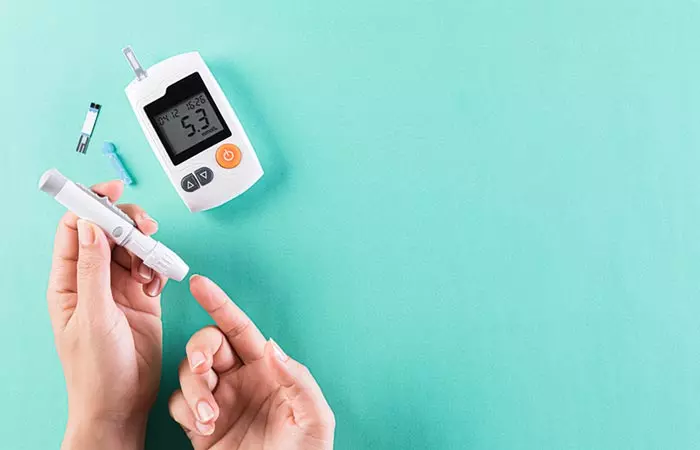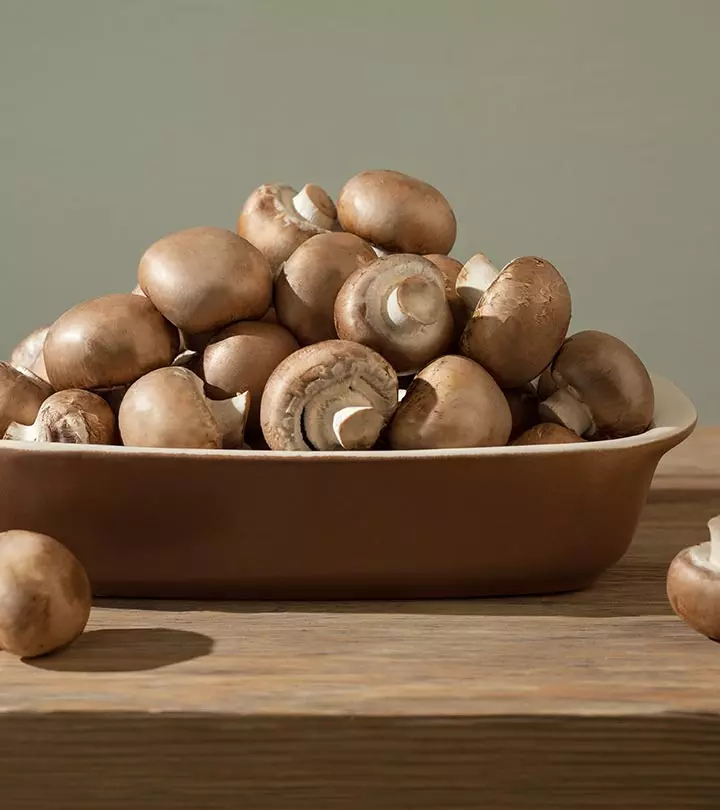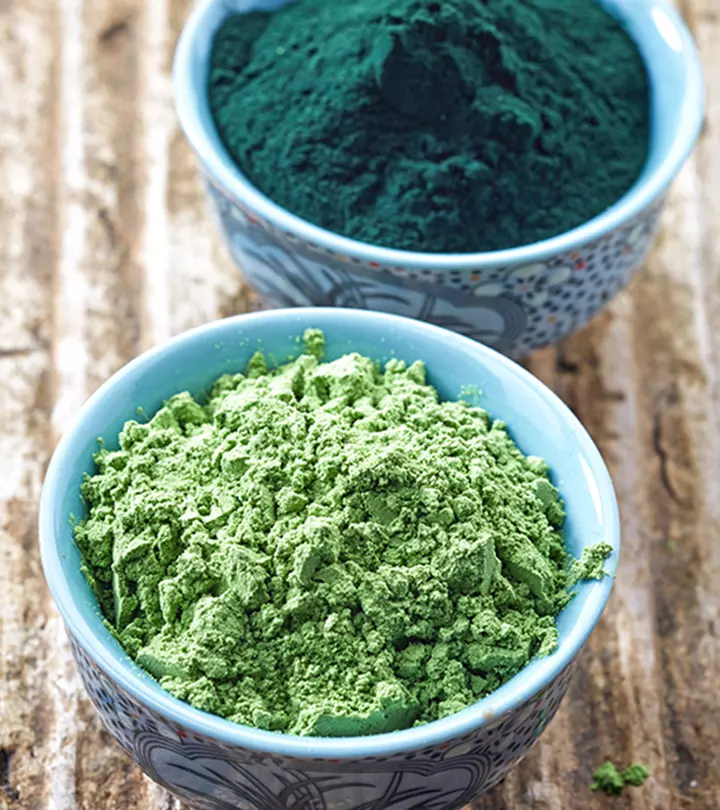Are Water Chestnuts Good For You? How To Eat Them?
Take your health up a notch by adding this rich underwater veggie to your diet!

Image: Shutterstock
Water chestnuts benefit you in multiple ways. This vegetable grows underwater. Many think that these belong to the family of chestnuts because of their name, but regular chestnuts grow on trees, and water chestnuts grow underwater.
Water chestnuts are widely used in Chinese, European, and Indian cuisines. They are fruits of aquatic plants that grow in shallow waters.
Recent research states that water chestnuts are loaded with minerals and antioxidants. But how do they improve your health? And what benefits do they offer? Are chestnuts good for you?
Get the answers to these queries from the article below. Keep reading to know more!
 Know Your Ingredient: Water Chestnut
Know Your Ingredient: Water ChestnutWhat Is It?
It is an underwater vegetable and is widely added in Asian cuisine, particularly in Chinese food.
What Are Its Benefits?
It is rich in antioxidants and helps in alleviating inflammation and in managing diabetes and blood pressure.
Who Can Consume It?
It is safe for most people to consume, except for people with diabetes.
How Often?
You can consume it daily but in moderation.
Caution
Excessive consumption may lead to stomach cramps, nausea, and vomiting.
In This Article
What Are Water Chestnuts? What Are Their Varieties?

Water chestnuts are not nuts. They are aquatic/underwater vegetables (or corms) that grow in China, India, and parts of Europe. Two species are grown under the name of water chestnuts – Trapa natans (a.k.a water caltrops or Jesuit nut) and Eleocharis dulcis (1), (2).
Trapa natans (water caltrop or ‘ling’) is grown in Southern Europe and Asia. Eleocharis dulcisis grown extensively in China. Therefore, Trapa natans is called the European water chestnut, while the latter is known as the Chinese water chestnut (1), (2)
The European chestnut has three to four spiky, angled, orthogonal, large fruits. The edible part is the nut-like inner core. The Chinese water chestnut, on the other hand, looks more like a turnip-shaped tuber – round and softer.
Both these species are invasive and aggressive weeds. They grow quickly and form dense mats on ponds, lakes, and shallow-deep water bodies (2).
However, locals enjoy eating these aquatic vegetables. Although water chestnuts are considered invasive, they are highly regarded for their culinary versatility and health benefits. It is a key ingredient in many cuisines, particularly in Asian dishes. Peeled water chestnuts are roasted, boiled, steamed, ground, and cooked in various ways. You can see it being widely used in authentic Chinese food.
 Trivia
TriviaEver wondered why? Let us take a quick look at the water chestnut nutrition profile and its associated benefits.
Keep reading!
Key Takeaways
- Water chestnuts are a nutritious, low calorie food that is native to Asia and Southern Europe.
- The antioxidants in water chestnuts may reduce inflammation and manage diabetes.
- Consuming water chestnuts daily can boost digestion and control blood pressure levels.
- You can consume them raw or add them to your soups, salads, or stocks.
- Always pick hard, white, and glossy water chestnuts with no pits or bruises for consumption.
Why Are Water Chestnuts Popular?
Water chestnuts are storehouses of minerals, vitamins, starch, fiber, and phenolic compounds.
Their starch and fiber content makes them a good addition to your regular diet.
Jordan Anthony, a Registered Dietitian Nutritionist, says, “Water chestnuts are highly nutritious, while also being low in calories. They have abundant essential vitamins and minerals, along with plenty of fiber. This makes them a good way to get your essential nutrition without consuming as many calories, helping with weight loss. They’re also a great source of antioxidants.”
Since they have a high nutritive value, water chestnut is linked to several health benefits. It is an essential component of Ayurveda. It is known for its diuretici Any substance or medication that encourages diuresis (excessive urine production) to flush out salt and water. , antiseptic, and digestive properties.
Water chestnut preparations can help treat dysenteryi An infection that spreads through contaminated food or water and causes intestinal inflammation and diarrhea. , diarrhea, hemorrhagei Acute bleeding from a ruptured blood vessel that can happen outside or inside the body and can be minor or fatal. , fractures, and inflammatory disorders (3). To know more about water chestnut benefits, scroll down!
What Are The Benefits Of Water Chestnuts?
Water chestnuts are high in antioxidants and anti-inflammatory compounds. These compounds aid in correcting digestive issues, anemia, and fatigue. They can also help reduce fever, pain, and inflammation.
1. Relieve Pain And Inflammation
According to clinical trials, water chestnut extracts inhibit the production of inflammatory compounds like interleukins and nitric oxide.
The active chemicals in this fruit downregulate the genes responsible for producing these compounds (4).
The phenolic antioxidants in water chestnuts scavenge free radicals in your system and prevent them from inducing organ damage, inflammation, and pain. Hence, water chestnut has a potent pain-relieving (analgesic) effect on your body (4).
With these properties, this aquatic vegetable can be used to treat skin irritation, stomach ulcers, fever, and age-related brain disorders (3), (4).
2. May Help In Managing Diabetes

Root vegetables like water chestnuts store water and nutrients and supply them to the plant. Hence, they are rich in fiber, minerals, antioxidants, and starches. Making water chestnuts a part of your diet may help manage diabetes (5), (6).
Though this vegetable has fair amounts of starch, its fiber and antioxidant content have the upper hand (5), (6).
3. Possess Antioxidant And Anticancer Effects
Potent antioxidant effects have been identified in various parts of water chestnut. Multiple experimental studies showed that the fruit and peel extracts of water chestnuts scavenged free radicals in subjects (7).
Hence, water chestnut can prevent/slow down lipid peroxidationi A metabolic process in the body that generates a chain reaction of reactive oxygen species degrading body fats. , tumor proliferation (growth and metastasis), and DNA damage induced by free radicals. Flavonoids like luteolin, fisetin, and diosmetin are responsible for this property (7), (8).
According to lab trials, Chinese and European water chestnuts may exert anticancer activity against human breast, lung, and colon cells (8).
4. May Lower Blood Pressure (Hypertension)

Water chestnuts are high in minerals. Compared to wheat flour, water chestnut flour has higher potassium, magnesium, zinc, and copper content. This flour also retains its antioxidant properties, unlike wheat flour. Including it in your diet can help in regulating blood pressure (9).
Along with water chestnuts, adding dark green leafy and cruciferous vegetables also enhances heart health. Such high-potassium foods are known to relax your heart muscles and prevent stroke (10).
Moreover, these vegetables are low in calories and carbohydrates. They may help people with hypertension to lose weight (10).
5. Exhibit Antimicrobial Activity
Water chestnut extracts can eliminate bacterial strains like Escherichia coli, Staphylococcus aureus, and Listeria monocytogenes. Shigella sonnei and Bacillus cereus were also found to be susceptible in another study. Water chestnut extracts inhibited the growth of helminths (worms and insects) as well (11), (12), (13).
These studies prove the antibacterial nature of green and red water chestnuts. Since they can kill several pathogenic strains, their extracts can be used to treat bacterial infections (11), (12).
Moreover, this antibacterial activity is comparable to the effect of standard antibiotics (like kanamycin). Therefore, adding water chestnut to your food may increase its shelf life (11). This plant may also purify water bodies with this antimicrobial effect.
Such health and ecological benefits are attributed to the mineral, vitamin, and phytochemical content of water chestnuts.
Find out more about their nutritional value in the following section.
Nutritional Profile Of Water Chestnuts
The water chestnut plant contains minerals like calcium, phosphorus, iron, copper, manganese, magnesium, sodium, and potassium. Due to this, they can be a rich source of energy and hydration, especially on a hot summer day.
The fruit kernels contain vitamins A, B, and C, and functional proteins.
The water chestnut fruits contain carbohydrates, minerals, and fair amounts of phenolic compounds. The flavonoids, flavones, saponins, phytosterols, oils, and tannins in them contribute to their antioxidant properties. It is these polyphenols that scavenge free radicals from your system (14).
Consuming water chestnuts means supplying your body with all these phytonutritional components, which can improve your overall immunity among other health benefits.
How can you do it? Can you eat raw water chestnuts, or should they be processed?
Keep reading for answers!
How To Use/Consume Water Chestnuts
Freshwater chestnuts can be eaten raw after peeling and washing them well. They are crispy and taste mildly sweet, similar to lotus root. However, always ensure to wash them properly before eating. Catherine Gervacio, a Registered Nutritionist-Dietitian, says, “Eating them raw or if not washed well can expose a person to bacteria or parasites. Best to make sure they are clean or cook them to make sure.”
No matter how long you cook or steam them, these corns have a magical power to remain crunchy.
Therefore, you often see them added to soups, ramen, stew/stocks, and any broth-like preparation for a fresh and crunchy twist. You can also pickle it to add a tangy flavor and extend its shelf life. The pickling process boosts their natural crunch and makes them a tasty condiment.
Don’t you want to taste water chestnuts? Let’s stir up something quick with them!
Here’s a simple recipe you can try in your kitchen right away!
Water Chestnut And Veggies Stir Fry

What You Need
- Olive oil: 1-2 tablespoons (enough for a stir fry)
- Water chestnuts: 1 ounce (canned or fresh), sliced
- Broccoli florets: 5-6, washed and cleaned
- Snow peas: 1 pound, fresh, trimmed
- Baby corn kernels: 6-8, fresh, sliced into halves
- Bell peppers: 1-2 medium-sized, sliced long
- Fresh mint: 1 tablespoon, chopped
- Sesame seeds: 2 tablespoons
- Salt: to taste
- Pepper: to taste
- Skillet: 1, medium-large
Let’s Make It!
- Place a large skillet over a medium-high flame and add olive oil.
- Once the oil is hot, stir in the broccoli, snow peas, baby corn, and bell peppers. Cook for 2-3 minutes.
- Toss in the water chestnuts, mint, and sesame seeds.
- Cook and stir well for about 3-5 minutes more, until the vegetables are tender.
- Sprinkle salt and pepper and give a final stir.
- Serve hot alongside rice, noodles, or flatbreads.
Such sides or stir-fries are a super healthy and tasty way of incorporating these nutty water vegetables into your diet.
This dish can give your body a boost of antioxidants and much-needed micronutrients.
You can find a horde of such quick, simple, and nutritious recipes with water chestnuts. They go very well with greens, chicken, and meat dishes.
You can dry water chestnuts and get them milled for flour. Water chestnut flour can be used in baking and cooking, similar to wheat flour.
 Quick Tip
Quick TipBut before you think about cooking with it, let’s talk about how to pick the best water chestnuts at the grocery store.
How To Buy Water Chestnuts
You can find fresh water chestnuts if you live close to a pond or a lake that has been invaded by this plant. If not, you can get them from supermarkets that sell international foods or Asian grocery stores.
Pick the hard and glossy ones. Ensure that they have no pits, bruises, or mushy spots. Good quality and healthy water chestnuts should look bright and white on the inside. They should taste sweet and nutty.
How To Store Water Chestnuts

After buying water chestnuts, store them unpeeled in paper bags in the refrigerator for up to a week. You can also freeze them in suitable containers. They last up to 5-6 months at 0ºF.
It is better to peel water chestnuts just before use. Storing peeled ones in water may rob them of their fresh taste and texture.
If you still wish to do so, keep them in this condition only for 2-3 days. Change the water every day.
Some of us find it convenient to cook and store such vegetables. The best way to do so is to boil water chestnuts, peel them, pack them in freezer bags/suitable containers, and freeze.
Label the bags with the date of packing. Leave enough headspace in each bag to prevent rotting or partial freezing.
Cooked, peeled, and frozen water chestnuts will last up to a year if stored the right way.
Another fuss-free option is using canned water chestnuts. Good quality water chestnuts are washed, peeled, and stored in brine (saltwater) before canning.
You can use canned water chestnuts just like the fresh ones. They taste similar. Once opened, the leftovers need to be stored in fresh, filtered water. Change the water every day.
How Can You Tell If Water Chestnuts Have Gone Bad?
Water chestnuts spoil quickly if not stored well. Do not use the canned contents if they smell off and feel slimy.
Fungal molds may develop in the containers if you don’t change the water. This can also happen in the cans.
Be careful when you are buying water chestnuts – fresh or canned ones.
Sometimes, the fresh ones may be picked from a lake/pond that has polluted/contaminated water. Therefore, stick to a trusted source/brand.
Also, check the expiration date and storage conditions before purchasing canned water chestnuts.
Water chestnuts provide an array of health benefits. But they may cause adverse effects in some individuals. Find out more about them below.
Side Effects Of Water Chestnuts
Catherine says, “Water chestnuts are generally safe for consumption, but some individuals may experience allergic reactions, which can cause symptoms like itching, swelling, or digestive discomfort.”
A case study published in the International Journal of Allergy Medications suggested that allergic reactions to water chestnuts are rare. However, it reported about a 57-year-old man of Asian origin who developed an allergic reaction to water chestnut flour. He experienced symptoms like breathlessness, hives, and loss of consciousness (15). Therefore, seek medical attention immediately if you experience an allergic reaction after consuming water chestnuts.
Anecdotal evidence also suggests that the excess consumption of water chestnuts may cause gas, bloating, and diarrhea. Also, due to lack of scientific research on the interaction of water chestnuts with medicines, consult your healthcare provider before consuming them if you are on any medications.
Infographic: 5 Ways Water Chestnuts Benefit Your Health
Water chestnuts are the fruits of underwater aquatic plants. They are widely used in European, Indian, and Chinese dishes as they are rich in antioxidants and minerals. They help improve your health and well-being. Check out the infographic below to learn more about the top 5 health benefits of water chestnuts.

Illustration: StyleCraze Design Team
Water chestnuts are aquatic tubers rich in vitamins and minerals. The benefits of water chestnuts can be attributed to their antioxidants, fiber, and starch compounds. These aquatic corns have antiseptic, digestive, and diuretic properties. They may help relieve pain and inflammation, regulate blood glucose levels, act against certain cancers, lower blood pressure levels, helps with detoxification, and treat several bacterial infections. You can use water chestnuts for stir-fries, or their flour can be used in baking. There are no recorded side effects of water chestnuts. Information regarding their safety is also limited. Hence, consult your doctor or dietitian before using water chestnuts.
Frequently Asked Questions
Does water chestnut lead to weight gain?
No, water chestnut does not lead to weight gain. In fact, its low-calorie content may help with weight loss and improve metabolism.
Is water chestnut good for the liver?
Yes, water chestnut is good for the liver. It contains vitamin B6 that helps promote liver function.
Are water chestnuts good for your skin?
Yes, water chestnuts are good for the skin. Their vitamins E and B and zinc promote skin health.
Does water chestnut cause body heat, or does it cool it down?
Water chestnut acts as a body coolant and is majorly consumed in summers.
Is chestnut good for fertility?
Yes, chestnuts are good for fertility. They contain beta carotene that helps in the production of enzymes needed for egg fertilization.
Do chestnuts cause gas?
Yes, eating excessive amounts of chestnuts may cause gas because of their carbohydrate content.
Is chestnut good for kidneys?
Yes, chestnut is good for kidneys as it is low in protein and potassium. It can also be taken by individuals with kidney disease.
Illustration: Are Water Chestnuts Good For You? How To Eat Them?

Image: Stable Diffusion/StyleCraze Design Team
References
Articles on StyleCraze are backed by verified information from peer-reviewed and academic research papers, reputed organizations, research institutions, and medical associations to ensure accuracy and relevance. Read our editorial policy to learn more.
- Water chestnut, NewCROP, Center for New Crops & Plant Products, Horticulture and Landscape Architecture, Purdue University.
https://hort.purdue.edu/newcrop/Crops/WaterChestnut.html - Water chestnut, Environmental Fact Sheet, New Hampshire Department of Environmental Sciences.
https://www.des.nh.gov/sites/g/files/ehbemt341/files/documents/2020-01/bb-43.pdf - Trapa bispinosa Roxb.: A Review on Nutritional and Pharmacological Aspects, Advances in Pharmacological Sciences, US National Library of Medicine, National Institutes of Health.
https://www.ncbi.nlm.nih.gov/pmc/articles/PMC3941599/ - Anti-Inflammatory Effects of Water Chestnut Extract on Cytokine Responses via Nuclear Factor-κB-signaling Pathway, Biomolecules & Therapeutics, US National Library of Medicine, National Institutes of Health.
https://www.ncbi.nlm.nih.gov/pmc/articles/PMC4286755/ - Non-Starchy Vegetables/Protein/Fat, Comprehensive Diabetes Center, University of Michigan.
https://www.med.umich.edu/1libr/MEND/Diabetes-NonCarbFoods.pdf - The pros and cons of root vegetables, Harvard Health Letter, Harvard Health Publishing, Harvard Medical School.
https://www.health.harvard.edu/staying-healthy/the-pros-and-cons-of-root-vegetables - Antitumor, Antioxidant, and Nitrite Scavenging Effects of Chinese Water Chestnut (Eleocharis dulcis) Peel Flavonoids. Journal of Food Science, US National Library of Medicine, National Institutes of Health.
https://pubmed.ncbi.nlm.nih.gov/27603811/ - DNA scission inhibition, antioxidant, and antiproliferative activities of water chestnut (Trapa natans) extracted in different solvents, National Agricultural Library, United States Department of Agriculture.
https://search.nal.usda.gov/discovery/search?query=lds35,contains,1258235-01nal_inst,AND&tab=LibraryCatalog&search_scope=MyInstitution&vid=01NAL_INST:MAIN&mode=advanced&offset=0 - Wheat-water chestnut flour blends: effect of baking on antioxidant properties of cookies, Journal of Food Science and Technology, US National Library of Medicine, National Institutes of Health.
https://www.ncbi.nlm.nih.gov/pmc/articles/PMC5223262/ - Potassium lowers blood pressure, Harvard Health Publishing, Harvard Medical School.
https://www.health.harvard.edu/heart-health/potassium-lowers-blood-pressure - Characterization and antimicrobial properties of water chestnut starch-chitosan edible films. International Journal of Biological Macromolecules, US National Library of Medicine, National Institutes of Health.
https://pubmed.ncbi.nlm.nih.gov/23831899/ - Environment friendly antibacterial activity of water chestnut fruits, Journal of Biodiversity and Environmental Sciences, CiteSeerX, The Pennsylvania State University.
https://citeseerx.ist.psu.edu/viewdoc/download?doi=10.1.1.654.4436&rep=rep1&type=pdf - Anthelmintic Activity of Fruit Peel and Root Extracts of Trapa natans L. var. bispinosa Roxb, Academic Journal of Plant Sciences.
https://citeseerx.ist.psu.edu/viewdoc/download?doi=10.1.1.414.755&rep=rep1&type=pdf - Pharmacognostical evaluation and phytochemical studies on Ayurvedic nutritional fruits of Trapa natans L. International Journal of Herbal Medicine, Academia.
https://www.academia.edu/19548752/Pharmacognostical_Evaluation_and_Phytochemical_studies_on_Ayurvedic_Nutritional_Fruits_of_Trapa_natans_L - Anaphylaxis to Water Caltrop (Singoda Flour): A Case Report, International Journal of Allergy Medications.
https://clinmedjournals.org/articles/ijam/international-journal-of-allergy-medications-ijam-5-040.php
Read full bio of Yvonne O’ Halloran
- Catherine Gervacio has been a Registered Nutritionist Dietitian for almost 20 years. Her areas of expertise include diabetes management, gut health, and weight management. She graduated from the University of Santo Tomas. She also has completed the International Fitness Certification approved by the International Sports Sciences Association and a certification for Managing Anxiety and Mental Health associated with Harvard University.She currently works with various medical and fitness brands like MSFit in Singapore and Fatless Life in Dubai, and also as a Health Coach with BetterMe.She also is the Co-founder of Nutrition First Corp, a nutrition and meal delivery service where she helps people meet their health goals by delivering diet consultations and customized healthy meals. Outside of work, Catherine enjoys outdoor activities with her family.
 Catherine Gervacio has been a Registered Nutritionist Dietitian for almost 20 years. Her areas of expertise include diabetes management, gut health, and weight management. She graduated from the University of Santo Tomas. She also has completed the International Fitness Certification approved by the International Sports Sciences Association and a certification for Managing Anxiety and Mental Health associated with Harvard University.She currently works with various medical and fitness brands like MSFit in Singapore and Fatless Life in Dubai, and also as a Health Coach with BetterMe.She also is the Co-founder of Nutrition First Corp, a nutrition and meal delivery service where she helps people meet their health goals by delivering diet consultations and customized healthy meals. Outside of work, Catherine enjoys outdoor activities with her family.
Catherine Gervacio has been a Registered Nutritionist Dietitian for almost 20 years. Her areas of expertise include diabetes management, gut health, and weight management. She graduated from the University of Santo Tomas. She also has completed the International Fitness Certification approved by the International Sports Sciences Association and a certification for Managing Anxiety and Mental Health associated with Harvard University.She currently works with various medical and fitness brands like MSFit in Singapore and Fatless Life in Dubai, and also as a Health Coach with BetterMe.She also is the Co-founder of Nutrition First Corp, a nutrition and meal delivery service where she helps people meet their health goals by delivering diet consultations and customized healthy meals. Outside of work, Catherine enjoys outdoor activities with her family. - Jordan Anthony is a Registered Dietitian Nutritionist with over 6 years of experience. She was a public relations professional before she went back to the University of Southern California to get a Master's degree in Nutrition, Healthspan and Longevity. She is currently serving as the Senior Director of Nutrition at Ahara Corporation in Los Angeles, USA.
 Jordan Anthony is a Registered Dietitian Nutritionist with over 6 years of experience. She was a public relations professional before she went back to the University of Southern California to get a Master's degree in Nutrition, Healthspan and Longevity. She is currently serving as the Senior Director of Nutrition at Ahara Corporation in Los Angeles, USA.
Jordan Anthony is a Registered Dietitian Nutritionist with over 6 years of experience. She was a public relations professional before she went back to the University of Southern California to get a Master's degree in Nutrition, Healthspan and Longevity. She is currently serving as the Senior Director of Nutrition at Ahara Corporation in Los Angeles, USA.
Read full bio of Swathi Handoo
Read full bio of Ravi Teja Tadimalla
Read full bio of Aparna Mallampalli



























Community Experiences
Join the conversation and become a part of our empowering community! Share your stories, experiences, and insights to connect with other beauty, lifestyle, and health enthusiasts.